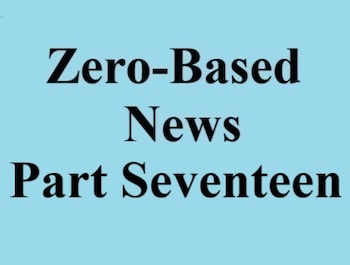Peirspictiochtai Ar An Saol
Zero-Based News
Part Seventeen

Self-censorship is a process that some in the news media utilize as they report the news. Instead of reporting information known to be factual, an individual in the news media or a news media entity decides not to report the information.
In some cases, there are situations where self-censorship is deemed acceptable by most people. These cases typically include situations of life and death.
A few examples:
A journalist has found out that the military is prepared to take action on foreign soil. The journalist contacts the military for confirmation, and the military representative asks that the journalist not report the information at that time because reporting the information would endanger military personnel. The journalist honors the request and holds the information for release until after military personnel are reported to be safely out of harm's way.
A television news station is broadcasting a live report of a hostage situation; a ten-second delay is utilized by the station prior to broadcasting any video from live reports. The station has several cameras on the scene. One of the cameras is trained on a specific site where law enforcement officials appear to be preparing to breach the structure. The individuals at the television station decide not to broadcast the live feed from that specific camera. The television news station retains the video for potential broadcast once the hostage situation has been resolved.
At the scene of a traffic accident, a news photographer decides not to take photos of the body parts that were burned and remained scattered along a highway. Instead, she takes photos of the motor vehicles involved in the crash and waits until coverings are placed over larger body parts before she takes additional photos.
Sometimes, there are situations of abuse and victimization where self-censorship is also considered acceptable by most people.
A couple of examples:
A news reporter sits in a court hearing where the name of an 11-year-old child is mentioned as being the victim of severe abuse by a parent. Because the child and the parent both share the same surname and live in the same home, the news reporter decides not to disclose the name of either the victim or the alleged perpetrator. Even after conviction, the news reporter decides not to disclose either name.
The specific street address of a domestic violence shelter is known by a journalist. Rather than include that street address in a news article, the journalist references the location of the shelter in a more general manner.
While these situations of self-censorship are generally considered acceptable by many people, other types of self-censorship may be considered unacceptable by those same people.
These situations of self-censorship can include ones designed to promote or protect a specific individual or a specific entity as well as ones where a specific individual or a specific entity may be put in a poor light.
In many cases, these types of self-censorship are done to avoid irritating or offending a specific individual or a specific entity.
A few examples:
A radio station gets news releases from John Smith and Alice Jones, both candidates for the same local political office. Both candidates are having rallies on the upcoming weekend. Top officials at the radio station have been the focus of social media attacks by supporters of Alice Jones. The individual at the assignment desk decides not to send a news reporter to the rally for John Smith, but does send a news reporter to the rally for Alice Jones. The radio station broadcasts a news report with positive details about the rally for Alice Jones; it includes a one-sentence note in the same news report about the rally for John Smith.
A newspaper reporter is provided with information about a local business that would be considered negative news if reported. The business is one of the major advertisers in the newspaper. The reporter discusses the subject with the newspaper editor who then discusses the matter with the publisher of the newspaper. The publisher decides that the information is important, but not quite ready for publication; the editor is told to have the reporter secure verifications about the information that are unlikely to be able to be secured by the reporter. Thus, no newspaper article is published.
A journalist checks with the local police department every weekday about arrests during the previous day/days. The logbook of arrestees includes the name of a prominent individual. The local police chief recommends that the journalist not make mention of the arrest of that individual; that if a news article is produced by that journalist, access to the logbook might be delayed. The police chief indicates that staffing levels in the office are in flux, and that the journalist might have to sit and wait for hours each day for someone to have the time to assist them in gaining access to the logbook. The journalist decides not to write a news article about the arrest of the prominent individual.
The next news column in this series will focus on how cherry-picking information impacts the reporting of news.
Peirspictiochtai Ar A Saol – Gaelic – Irish – for "Perspectives On Life" is a column focused on aspects of accountability and responsibility as well as ways people look at life.
Contact Richard McDonough at
© 2025 Richard McDonough










